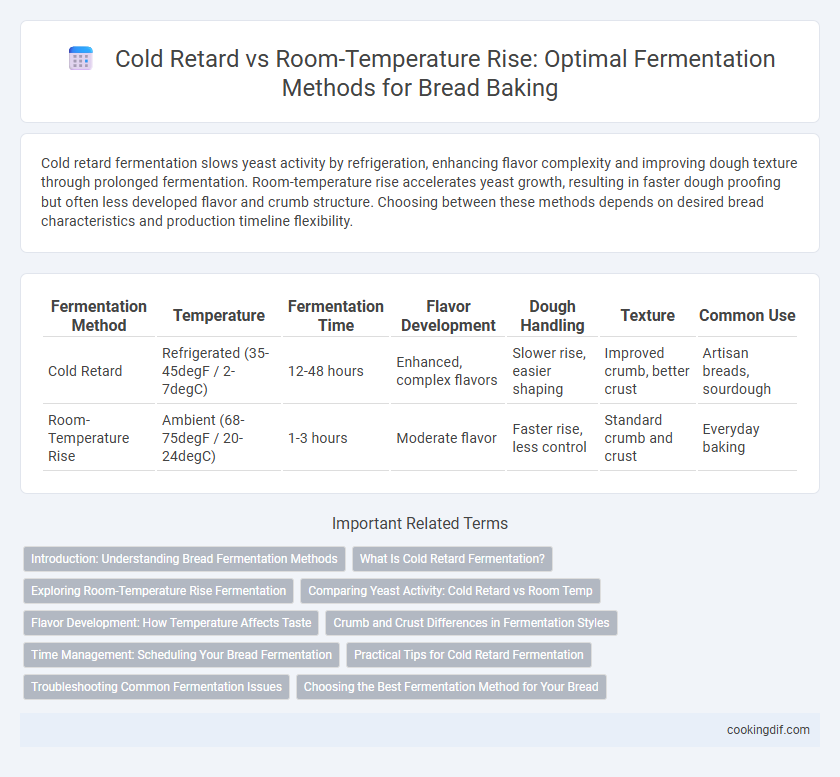Cold retard fermentation slows yeast activity by refrigeration, enhancing flavor complexity and improving dough texture through prolonged fermentation. Room-temperature rise accelerates yeast growth, resulting in faster dough proofing but often less developed flavor and crumb structure. Choosing between these methods depends on desired bread characteristics and production timeline flexibility.
Table of Comparison
| Fermentation Method | Temperature | Fermentation Time | Flavor Development | Dough Handling | Texture | Common Use |
|---|---|---|---|---|---|---|
| Cold Retard | Refrigerated (35-45degF / 2-7degC) | 12-48 hours | Enhanced, complex flavors | Slower rise, easier shaping | Improved crumb, better crust | Artisan breads, sourdough |
| Room-Temperature Rise | Ambient (68-75degF / 20-24degC) | 1-3 hours | Moderate flavor | Faster rise, less control | Standard crumb and crust | Everyday baking |
Introduction: Understanding Bread Fermentation Methods
Cold retard fermentation extends dough rising in refrigeration at 3-7degC, enhancing flavor complexity by slowing yeast activity and promoting enzyme development. In contrast, room-temperature fermentation occurs at 20-25degC, accelerating yeast metabolism for faster dough rise but producing a milder flavor profile. Selecting between cold retard and room-temperature rise impacts crumb texture, aroma, and overall bread quality, tailoring the fermentation process to specific baking goals.
What Is Cold Retard Fermentation?
Cold retard fermentation is a slow fermentation process where dough is refrigerated at temperatures typically between 1degC and 7degC after initial mixing and shaping. This method enhances flavor development by allowing enzymes and yeast to work gradually, producing more complex aromas and a chewier crumb texture. Compared to room-temperature rise, cold retard fermentation extends fermentation time, improves dough strength, and improves crust coloration in artisan bread.
Exploring Room-Temperature Rise Fermentation
Room-temperature rise fermentation accelerates yeast activity by maintaining dough at approximately 24-27degC, promoting faster carbon dioxide production and gluten development compared to cold retard methods. This technique enhances flavor complexity and crumb texture through controlled enzymatic reactions without the extended proofing time required in refrigeration. Optimal temperature management during this fermentation ensures balanced yeast metabolism, resulting in bread with improved volume, crust color, and aromatic profile.
Comparing Yeast Activity: Cold Retard vs Room Temp
Cold retard fermentation slows yeast activity significantly by maintaining dough at temperatures between 35degF to 45degF, resulting in a longer, more controlled rise that develops complex flavors and improved texture. In contrast, room-temperature fermentation accelerates yeast activity at around 70degF to 75degF, producing a faster rise but with less nuanced flavor and denser crumb structure. Yeast metabolism during cold retard is slower, preserving sugars and generating more organic acids, whereas room-temperature fermentation leads to rapid CO2 production and quicker proofing times.
Flavor Development: How Temperature Affects Taste
Cold retard fermentation slows yeast activity at temperatures between 35degF and 45degF, enhancing complex flavor compounds like esters and organic acids, resulting in a richer, more nuanced bread taste. Room-temperature rise, typically at 70degF to 75degF, accelerates fermentation, producing bread with a more straightforward, yeasty flavor profile and less depth of taste. The slower enzymatic reactions during cold retard allow greater sugar breakdown and Maillard reactions during baking, intensifying aroma and crust color.
Crumb and Crust Differences in Fermentation Styles
Cold retard fermentation slows yeast activity, resulting in a tighter crumb structure and more pronounced crust caramelization, enhancing flavor complexity and crust crispness. Room-temperature rise accelerates fermentation, producing a more open crumb with larger air pockets and a softer, less developed crust. These fermentation styles significantly impact bread texture and crust characteristics, influencing overall sensory experience.
Time Management: Scheduling Your Bread Fermentation
Cold retard fermentation slows yeast activity by chilling the dough between 38degF and 50degF, extending rise time up to 12-48 hours for enhanced flavor development and flexible baking schedules. Room-temperature fermentation occurs around 70degF to 75degF, allowing dough to rise in 1-3 hours, ideal for faster turnaround and immediate baking needs. Effective time management balances these methods by leveraging cold retard for overnight or delayed bakes and room-temperature rise for same-day preparation.
Practical Tips for Cold Retard Fermentation
Cold retard fermentation slows yeast activity by maintaining dough at temperatures between 38degF and 45degF, enhancing flavor complexity and crust development. Practical tips include tightly sealing dough in airtight containers to prevent moisture loss and allowing extended fermentation times of 12 to 48 hours for optimal enzyme activity. Monitoring dough temperature with an instant-read thermometer ensures consistent fermentation while preventing over-proofing and sourness.
Troubleshooting Common Fermentation Issues
Cold retard fermentation slows yeast activity at lower temperatures, enhancing flavor complexity and extending proofing time, which helps prevent overproofing and underdeveloped dough structure. Room-temperature rise accelerates yeast activity, reducing fermentation time but increasing the risk of overproofing and uneven gas distribution, leading to dense or collapsed loaves. Troubleshooting common fermentation issues involves monitoring dough temperature closely, adjusting proofing duration, and ensuring consistent environmental conditions to achieve optimal crumb texture and rise.
Choosing the Best Fermentation Method for Your Bread
Cold retard fermentation slows yeast activity by keeping dough at 35-45degF (2-7degC), enhancing flavor complexity and crumb texture over 12-72 hours. Room-temperature rise fermentation operates around 70-75degF (21-24degC), delivering faster proofing times typically within 1-3 hours while producing a lighter and more open crumb. Choosing the best method depends on desired bread characteristics: cold retardation is ideal for artisan loaves with depth of flavor, whereas room-temperature rise suits quick baking and softer crumb profiles.
Cold Retard vs Room-Temperature Rise for fermentation methods Infographic

 cookingdif.com
cookingdif.com